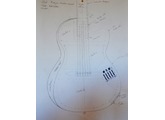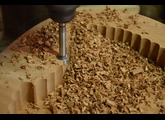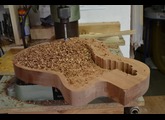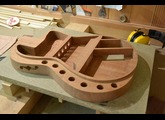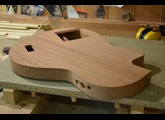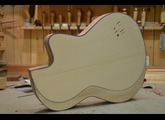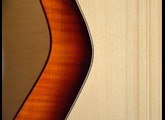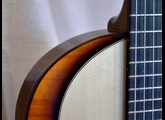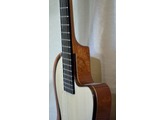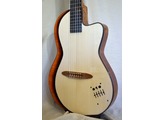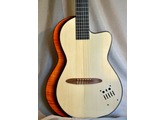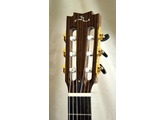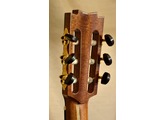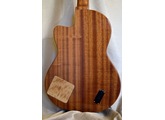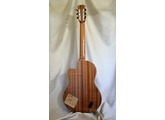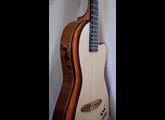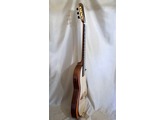« An electric beauty »
Published on 10/31/17 at 06:28
Best value:
Excellent
Audience:
Advanced Users
Of course this guitar does deserve 5 stars – but frankly, how objective can you be when judging a unique, custom-designed model made for you to your own specs? You’d have to judge by yourselves, but I don’t see you being disappointed by Jérôme.
This guitar originates in a desire I’d had since 1987 : owning a solid bodyn electric guitar with nylon strings. My inspiration was Gibson’s Chet Atkins CE, which was a real revolution as to amplified classical guitars. But after dreaming and reading a lot about it, you soon find out how Atkins himself had ended up delusioned by the CE. While it featured a real on-stage presence, it also turned out to be very heavy, being a solid body model. Also, the absence of wood vibration (hence a lack of natural-sounding character) was another problem. Today, such issues have been addressed by Godin as well as some American luthiers, but I had met Jérôme Marchand and really wanted to ask him to work on such a project, so we designed a model together.
Regarding the body, we kept the concept of a hardwood solid body (AAA African mahogany) with a 5cm width. The shape is that of a classical guitar, but with a cutaway. To reduce the weight, Jérôme suggested to carve 3 chambers in it – plus the part where the electronic parts go. Weighing in at 3.4 kg (approx. 7.5 lbs), it’s only 100g heavier compared with my small Aria Pro II electric guitar. The main binding is made of Indian rosewood, and next to it is a 10mm-wide flame maple, wave-shaped and bevelled sunburst-colored armrest that looks like 3D-ish in a very innovative way. The lower binding is made of flame maple.
The bridge is made of satin moiré wood. In the back, a moiré wood backplate protects the electronics. The guitar’s finish is bright and polished. The lower side is flat so as to make things easier when the guitar rests on one’s knee (slightly carving the upper part of the back would have been a good idea for when I play while standing).
A violin-like f-hole was carved into the side so as to let the instrument ring naturally, even without an amp.
The 1st-choice mahogany neck is equipped with a dual-action trussrod. The fingerboard is made of ebony and features standard markers on the side on the 3rd, 5th, 9th, 12th, 15th and 17th frets. The frets are Jim Dunlop 6130 Vintage Standard. The nut is made of bone and is 47.5mm wide (hence slightly narrower than a classical guitar). The neck and body join using a 6mm-deep tenon and mortise joint at the 14th fret (with a 58-mm width). It feels incredibly sturdy. The head adorns an Indian rosewood veneer and a mother-of-pearl “JM” logo. Tuners are Schaller HG1 with ebony buttons.
The guitar’s top is made of AAAA spruce, and its vibration allows for a more natural sound amplification.
As usual, Jérôme made a guitar which is not only beautiful but also very playable with a precisely intuned neck which features an ideal width – neither too wide which would be a problem for some pop/rock gestures, nor too narrow which would induce strings to slide out). Sustain is long and the harmonics come naturally. This guitar is very comfortable to play – I’d be curious for the opinion of an experienced classical player.
The sound can be amplified using RMC Acoustic Gold Pickups, which are individual pickups for each string which height can be set separately. They offer an enhanced dynamic response and synth tracking, and are very little sensible to feedback. Signal-to-noise ratio is excellent (100 dB S/N).
The included preamp is an RMC Poly Drive 4. It is mounted from the inside, which ensures reliability, discretion and a very practical position, close to the right hand. It features a 3-band EQ with selectable mid frequencies (700Hz or 1200Hz) and a DMX feedback reducer. Instrument volume and synth volume settings are also present, with two selectors for remote-switching the synth banks. The synth tracking and dynamic response are excellent. It is compatible with all available guitar synth modules and works with phantom power or a mere 9V battery (which is offset to be more easily accessible). Excellent signal-to-noise ratio (90 dB S/N).
The guitar features two sound outputs : a classic jack that allows to directly amplify the instrument’s natural sound, and a 13-pin plug that allows to get into synth equipments (e.g. Roland’s GR55). These outputs are side by side, at 5:00 when looking at the front of the guitar, on a slight cutaway on the side.
The sound is very accurate with an impressive sustain. The RMC is so powerful than in spite of their recommendation to use the “high” setting for classical guitars, I set it to “low”. I play on a Jazz Chorus 50, also using the “low” input.
This is a nylon-stringed guitar. It sounds perfect for classical music and all genres that come with that kind of sounds (a wide array of genres by the way, depending on the artist’s creativity). But used with an electronic gear that picks up the data through its 13-pin plug, there’s no limit to what it can do! It provides modelled electric guitar sounds on various amps and stacks, and can benefit from all possible effects. It allows string-by-string settings, and so on – but that is something else, not linked with the instrument itself.
This guitar’s name is Elbe – a name that comes from Electric Beauty, but LB are also my initials. As to the city of Hamburg...
This guitar originates in a desire I’d had since 1987 : owning a solid bodyn electric guitar with nylon strings. My inspiration was Gibson’s Chet Atkins CE, which was a real revolution as to amplified classical guitars. But after dreaming and reading a lot about it, you soon find out how Atkins himself had ended up delusioned by the CE. While it featured a real on-stage presence, it also turned out to be very heavy, being a solid body model. Also, the absence of wood vibration (hence a lack of natural-sounding character) was another problem. Today, such issues have been addressed by Godin as well as some American luthiers, but I had met Jérôme Marchand and really wanted to ask him to work on such a project, so we designed a model together.
Regarding the body, we kept the concept of a hardwood solid body (AAA African mahogany) with a 5cm width. The shape is that of a classical guitar, but with a cutaway. To reduce the weight, Jérôme suggested to carve 3 chambers in it – plus the part where the electronic parts go. Weighing in at 3.4 kg (approx. 7.5 lbs), it’s only 100g heavier compared with my small Aria Pro II electric guitar. The main binding is made of Indian rosewood, and next to it is a 10mm-wide flame maple, wave-shaped and bevelled sunburst-colored armrest that looks like 3D-ish in a very innovative way. The lower binding is made of flame maple.
The bridge is made of satin moiré wood. In the back, a moiré wood backplate protects the electronics. The guitar’s finish is bright and polished. The lower side is flat so as to make things easier when the guitar rests on one’s knee (slightly carving the upper part of the back would have been a good idea for when I play while standing).
A violin-like f-hole was carved into the side so as to let the instrument ring naturally, even without an amp.
The 1st-choice mahogany neck is equipped with a dual-action trussrod. The fingerboard is made of ebony and features standard markers on the side on the 3rd, 5th, 9th, 12th, 15th and 17th frets. The frets are Jim Dunlop 6130 Vintage Standard. The nut is made of bone and is 47.5mm wide (hence slightly narrower than a classical guitar). The neck and body join using a 6mm-deep tenon and mortise joint at the 14th fret (with a 58-mm width). It feels incredibly sturdy. The head adorns an Indian rosewood veneer and a mother-of-pearl “JM” logo. Tuners are Schaller HG1 with ebony buttons.
The guitar’s top is made of AAAA spruce, and its vibration allows for a more natural sound amplification.
As usual, Jérôme made a guitar which is not only beautiful but also very playable with a precisely intuned neck which features an ideal width – neither too wide which would be a problem for some pop/rock gestures, nor too narrow which would induce strings to slide out). Sustain is long and the harmonics come naturally. This guitar is very comfortable to play – I’d be curious for the opinion of an experienced classical player.
The sound can be amplified using RMC Acoustic Gold Pickups, which are individual pickups for each string which height can be set separately. They offer an enhanced dynamic response and synth tracking, and are very little sensible to feedback. Signal-to-noise ratio is excellent (100 dB S/N).
The included preamp is an RMC Poly Drive 4. It is mounted from the inside, which ensures reliability, discretion and a very practical position, close to the right hand. It features a 3-band EQ with selectable mid frequencies (700Hz or 1200Hz) and a DMX feedback reducer. Instrument volume and synth volume settings are also present, with two selectors for remote-switching the synth banks. The synth tracking and dynamic response are excellent. It is compatible with all available guitar synth modules and works with phantom power or a mere 9V battery (which is offset to be more easily accessible). Excellent signal-to-noise ratio (90 dB S/N).
The guitar features two sound outputs : a classic jack that allows to directly amplify the instrument’s natural sound, and a 13-pin plug that allows to get into synth equipments (e.g. Roland’s GR55). These outputs are side by side, at 5:00 when looking at the front of the guitar, on a slight cutaway on the side.
The sound is very accurate with an impressive sustain. The RMC is so powerful than in spite of their recommendation to use the “high” setting for classical guitars, I set it to “low”. I play on a Jazz Chorus 50, also using the “low” input.
This is a nylon-stringed guitar. It sounds perfect for classical music and all genres that come with that kind of sounds (a wide array of genres by the way, depending on the artist’s creativity). But used with an electronic gear that picks up the data through its 13-pin plug, there’s no limit to what it can do! It provides modelled electric guitar sounds on various amps and stacks, and can benefit from all possible effects. It allows string-by-string settings, and so on – but that is something else, not linked with the instrument itself.
This guitar’s name is Elbe – a name that comes from Electric Beauty, but LB are also my initials. As to the city of Hamburg...

